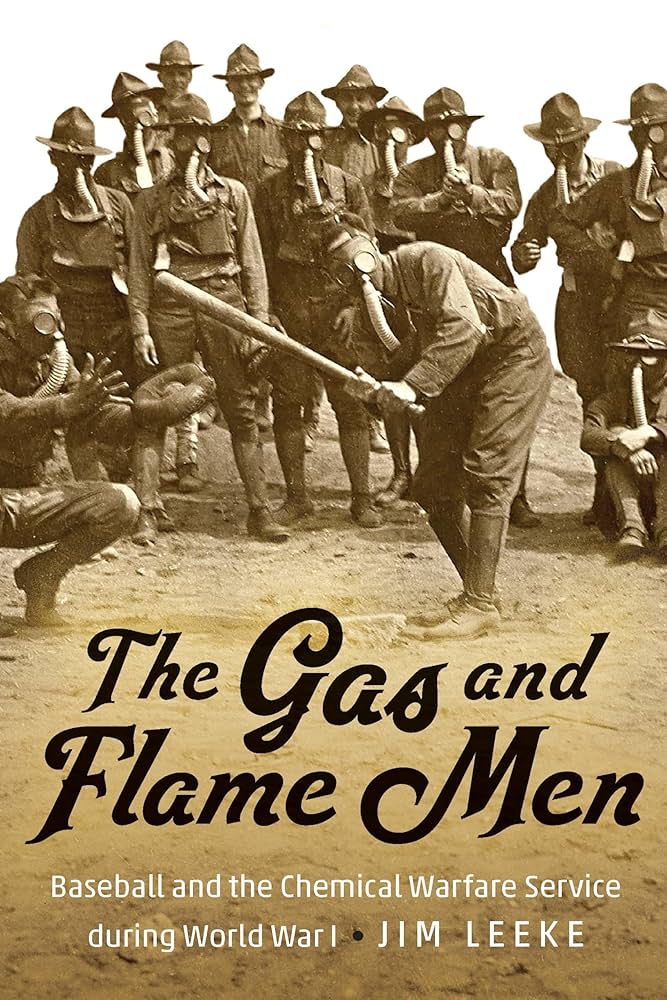By Jim Leeke.
Lincoln, NE: Potomac Books, 2024.
ISBN 978-1-64012-605-3. Photographs. Illustrations. Notes. Bibliography. Index.
Pp. 256. $32.95.
In The Gas and Flame Men, author Jim Leeke focuses on the experiences of major league baseball players who served in the U.S. Army’s Chemical Warfare Service during World War I. Along the way, his smooth-flowing narrative touches on various aspects of the World War I era that probably are not generally known either to baseball fans or to casual readers of history.
Although modest in length, with 165 pages of actual text, The Gas and Flame Men is crammed with facts, including a summation of the development of gas warfare. The Germans developed the flamethrower in 1914 and launched the first poison gas attack in 1915. After the United States entered the war in 1917, American scientists and military leaders rushed to develop chemical weapons and recruit soldiers to use them.
A number of then-current and former baseball players, and at least two club executives, found their way into the brand-new Chemical Warfare Service (CWS). Among them were five future Hall of Famers: Christy Mathewson, Ty Cobb, George Sisler, Eppa Rixey, and Branch Rickey (enshrined as a general manager). Former catcher, manager, and announcer Charles “Gabby” Street rounds out the group featured prominently in the book. Various figures from baseball and other sports make shorter appearances.
These players-turned-soldiers did not wind up in chemical warfare by random chance, but actually sought the assignment, sometimes after being recruited by others. Explaining why the CWS was appealing, Leeke reveals the mindset of a different era. Even as gas testing was consigning stray or abandoned dogs and cats to agonizing deaths, poison gas was marketed to the American public as a humane alternative to traditional explosives.
Army marketing specialists of the time thought prominent athletes (and other citizens, such as congressmen) serving in the CWS would make gas warfare more acceptable. Civilians themselves were asked to collect fruit pits and shells of nuts for charcoal for gas masks. Another theory, from those with a more tactical outlook, was that baseball players were “natural quick thinkers” who could devise “new methods of coercing Jerry [the Germans] out into the open for American gas displays” (p. 123).
Without belaboring the point, Leeke demonstrates that while some of the players in the book may have delayed entry into the service for a time to conclude a baseball season, some were indifferent about their service. “I joined the army to fight and do my bit…My work has to do with the practical application of gas on the enemy,” Ty Cobb, one of the sport’s all-time great hitters, told a sportswriter (p. 106). At age thirty-one, with a wife and three children, Cobb was confident he could have been deferred from service.
Like Cobb, many of these players were no longer young, suggesting they might have secured a noncombat assignment or contributed to the war effort in a non-military role. Mathewson was thirty-seven and Rickey was thirty-six. Street, who, amazingly, had served as a teenager during the Spanish-American War, was thirty-four when he joined the Army for the second time.
Ultimately, only two of the profiled players, Street and Rixey, reached the actual front lines (where Street was wounded). The war ended while the others were still making their way forward. Rickey and Mathewson were delayed by contracting influenza on the way to France. Rickey, who developed pneumonia, was hospitalized for three weeks, “Matty” for eight days.
Even without combat, the CWS men faced hazards. Mathewson was exposed to gas during training. That led to a lingering controversy, which Leeke explores, about whether the exposure caused him to contract tuberculosis, resulting in his untimely death at the age of forty-five.
Leeke’s experience writing two other books about baseball and World War I no doubt helped him weave together what might seem to be widely disparate subjects. Readers looking for an account of combat will not find it here. For those whose interests combine old-time baseball and military history, The Gas and Flame Men will open a window into a fascinating, often forgotten era, while calling back to the spotlight some brave Americans who were more than just famous athletes.
Darrell Smith
Champaign, Illinois
